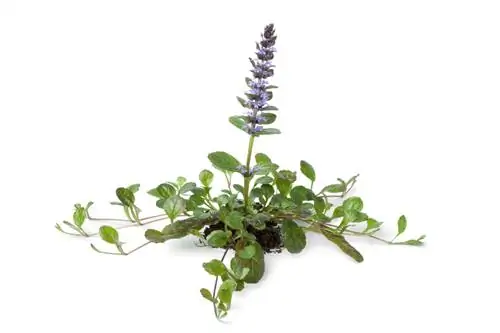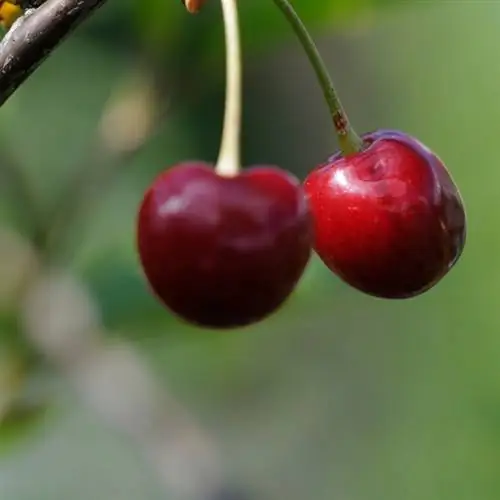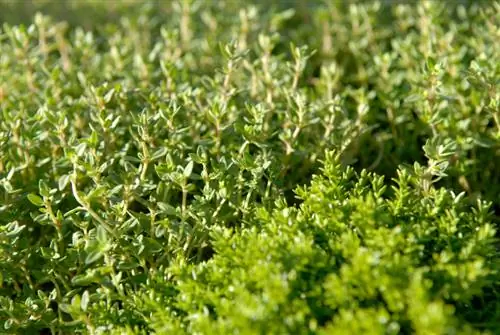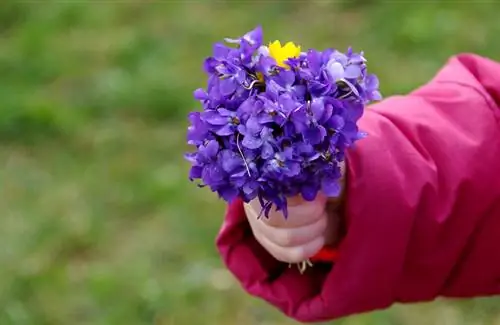- Author admin [email protected].
- Public 2023-12-16 16:46.
- Last modified 2025-06-01 06:02.
The pretty, mostly blue-flowering creeping Günsel is ideal for greening larger areas in the sun or partial shade. The attractive plant also cuts a fine figure in balcony boxes and pots. The greatest ornamental value of this old medicinal plant is its foliage, which even remains wintergreen - although it can suffer in very hard frosts.

What are the characteristics of the Creeping Gunsel?
The creeping gunsel (Ajuga reptans) is a perennial, hardy ornamental and medicinal plant that grows 10 to 30 cm high. It prefers sunny to partially shaded locations, moderately moist and nutrient-rich soil. The blue, pink or white flowers appear from April to June and the foliage is wintergreen.
Creeping Günsel - data and facts at a glance
- Botanical name: Ajuga reptans
- Popular names: Creeping Günsel, Meadow Günsel, Güldengünsel, Gurgelkraut
- Family: Mint family (Lamiaceae)
- Origin and distribution: Europe, North Africa, Iran
- Location: in open and partially shaded meadows, in deciduous forests, on forest edges, in hedges and gardens with nutrient-rich soil
- Growth: herbaceous
- Perennial: yes
- Height: 10 to 30 centimeters
- Flower: false whorls
- Colors: blue, pink or white
- Flowering period: April to June
- Fruit: Four-part Claus Fruit
- Leaves: arranged in rosettes around the stem; green, silvery-green or brown-red colored
- Propagation: seeds, division
- Winter hardiness: yes
- Toxicity: no
- Use: ornamental and medicinal plant
- Harvest time: May to June (flowers)
Identification features of the Creeping Günsel
The creeping Günsel spreads very quickly through root runners and self-sowing; it is very assertive. Egg-shaped, slightly curved and wavy - sometimes more serrated - wintergreen leaves about six to eight centimeters long spread flat in loose rosettes. The non-hairy foliage usually remains lower than ten centimeters. Between April and June, inflorescences between 15 and 25 centimeters long appear with flowers about two centimeters long - mostly violet-blue - which are in a squat raceme. The varieties with patterned or brown-red colored leaves are very attractive.
Growing the Creeping Gunsel in the Garden
A sunny to partially shaded spot is just the thing. Günsel that is too shady easily gets mildew, which can occur not only in problem locations, but also in very wet years. However, the plants are usually so vigorous and robust that the infestation has little effect and is primarily an aesthetic defect. However, the soil must not dry out too much - the creeping Günsel prefers moderately moist, nutrient-rich soil.
Use as a medicinal plant
Traditionally, creeping Günsel is used internally and externally as an infusion. Drinked as a tea, the plant is said to help against heartburn, inflammation of the oral mucosa, tonsillitis or insomnia; externally for wounds, scars or ulcers. The plant mainly contains essential oils and tannic acids.
Tip
Quite well known and rightly popular is the comparatively large-leaved variety “Catlin’s Giant”, whose initially deep red leaves turn into a dark shade of green over the course of the year. The attractive flowers are bright violet-blue in color.






